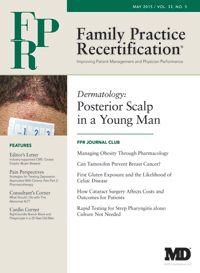Publication
Article
Family Practice Recertification
First Gluten Exposure and the Likelihood of Celiac Disease
This was a prospective multinational birth cohort study to determine if the age of first gluten introduction was associated with increased risk for celiac disease in genetically predisposed (high risk) children.
Review
“Age at Gluten Introduction and Risk of Celiac Disease” Pediatrics 2015; 1787
Study Methods
Newborns were screened for high-risk CD HLA-genotypes. Those identified as high-risk had feeding information collected every 3 months. From 24 months of age, these children were screened annually for elevated tissue transglutaminase autoantibodies (tTGA) indicating celiac disease autoimmunity (CDA). Diagnosis of CD via intestinal biopsy was also an outcome evaluated over the 5-year follow-up period.
Results and Outcomes
Of the 6,436 high-risk children followed, 12% developed celiac disease autoimmunity (CDA) and 5% were diagnosed with CD. This is compared to the risk of a low risk child for CD of about 2% (3). The age of first exposure varied between countries, with a median age of 21.7 weeks in Sweden and 30.4 weeks in the United States. The authors also noted that timing of gluten introduction, specifically before 4 months or after 6 months of age, was not associated with risk of developing CD.
Conclusion
Even for those considered at high risk, the age at which gluten was first introduced was not considered an independent risk factor for developing CD.
Commentary
Up until 2012, the American Academy of Pediatrics recommended introducing solid foods, including small amounts of gluten, between 4 and 6 months. This “window of opportunity” gained favor following a series of publications detailing an epidemic of CD in Sweden between 1973 and 1997. Subsequent prospective observational studies were in agreement. 1,2 In early 2012, The AAP changed to be consistent with the WHO, who recommended delaying all solids until after 6 months of age.
As the diagnosis of CD continues to grow, and with it, its clinical implications, this study provides significant reassurance that age of initiation of gluten containing foods does not seem to be causative in the first 5 years of life. By observing a variety of populations’ unique feeding habits, a broad perspective is obtained without putting a child at risk. This strength gives the study significant credence. Nationality and its genetic predispositions did not have an impact according to the authors. One limitation of this study was the amount and frequency of gluten consumption was not standardized; only the timing of first exposure was measured. This leaves open the possibility that both introduction and volume of gluten can play a role.
Strong data on risk of other disorders support waiting to introduce solid foods until 6 months of age. This may be financially costly for those parents using commercially available formula, which can be quite expensive. Nonetheless, the health benefits of this delay results in reducing risk from obesity, type 2 diabetes mellitus), asthma, allergic rhinitis and eczema.
With the 6-month limit as a standing rule, this study indicates the timing of gluten introduction is not associated with risk for developing the celiac disease.
1. Ivarsson A, Persson LA, Nystom L, et al. Epidemic of coeliac disease in Swedish children. Acta Paediatrica 2000;89:165-71.
2. Norris JM, Barriga K, Hoffenberg EJ, et al. Risk of celiac disease autoimmunity and timing of gluten introduction in the diet of infants at increased risk of disease. JAMA 2005;293:2343-51.
3. Pediatrics 2013;131:e687—e694






